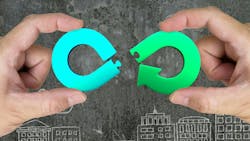Remaking manufacturing through more materials recycling
By Jennifer Ramsay
Circular CEO Ian Arthurs didn’t start his career with sustainability in mind. When he graduated business school in 2006, sustainability was, in his own words, “a niche thing.” Today, 19 percent of Stanford Business grads are planning careers in it. Instead, Arthurs started at Google in 2007 before moving on to TaskRabbit, which was eventually acquired by Ikea, where he first got to talking with folks in the sustainability industry.
“[Ikea] was my first time working for a company that made things … I ended up talking to the sustainability folks, and Ikea has a deeply sustainable kind of vein in its DNA and aimed to decrease their dependency on virgin materials, like oil-based materials, by 2030, and they really struggled doing that,” he said.
Eventually, he found that it wasn’t just an isolated problem: Many large manufacturers were and still are struggling with the green transition and using recycled materials. That lightbulb moment led to his startup, Circular, a digital platform that incorporates AI to connect buyers and suppliers of recycled plastic.
Since its 2021 debut, Circular has added more than 9,000 global suppliers, allowing buyers to source tons of post-consumer recycled material (35,000 in Q4 of 2023 alone) as it progresses towards its vision of moving the plastics industry to a circular economy.
The idea of circularity has been around for decades, although it’s hard to trace its exact origins. Magdi Azer of the Remade Institute, which focuses on developing technologies to accelerate the U.S.’ transition to a circular economy, defines it as a “closed-loop system.”
“[Circularity] is such that products that we make or the materials and resources that we use can be reused in different applications or the same application that can be repaired,” he said. “When parts get worn, they can be remanufactured to restore the product like a John Deere tractor or a Caterpillar tractor to as-new condition. So basically, you get another full life out of it.”
This is in opposition to the current model, a linear ecosystem, where the following happens:
- Extract resources from the ground
- Use them to make or manufacture products
- Use those products
- Throw them away in landfills or discard at home (think of all the old cell phones you might have)
The main problem with the linear model, according to Azer, is that for a linear economy to grow, “you have to consume more and more resources.” But a circular economy works to separate economic growth not only from material consumption, but also environmental impact, which can be “a challenge.”
According to a recent report from the International Resource Panel, a division of the United Nations Environmental Program, not only has the world tripled its resource consumption in the past 50 years, but between now and 2060, the consumption is expected to grow another 60 percent.
In 2023, companies produced 130 million tons of virgin plastic. As of 2019, only roughly 9 percent of plastic was actually recycled into new materials. Emissions from plastics production — nearly 2 billion tons — account for 3.3 percent of global greenhouse gases.
The problem isn’t just environmental. Microplastics, plastic pieces less than 5 millimeters across, have been found in human lungs, placental tissues, breast milk and blood.
But plastics are, for now, here to stay, so efforts are focused on stopping more plastic from entering the system, hence the need for circularity. Some organizations, like the Remade Institute, are tackling the problem from an early-stage application and research perspective.
The Institute, which is partially funded by the Department of Energy’s Office of Advanced Materials and Manufacturing Technologies, regularly releases requests for proposals on various subjects. To date, it has provided nearly $100 million in funding to almost 100 projects focusing on accelerating the transition to a circular economy.
Some of those projects are:
- Identification of Mixed Plastics and Valuable Electronics at the Source
- Recycling Technologies for Silicon Solar Modules
- Determining Material, Environmental and Economic Efficiency of Sorting and Recycling Mixed Flexible Packaging and Plastic Wrap
Other entities, like Circular, want to make it easier for those trying to take immediate action. For now, the platform focuses on recycled plastics because “it’s so visible a problem,” according to Arthurs, although the model could eventually be applied to anything with a sustainable element such as paper, glass or even garbage and municipal waste materials.
The company recently announced it raised $10.5 million in funding to scale the business. The first seed round led by Eclipse raised $5.2 million, while the second raised $5.3 million, backed by venture capital firms Maniv, Oxygea, and Eclipse. Arthurs said the money will primarily go to hiring experienced people to further the platform. Long term, he hopes to extend Circular’s physical presence and material offerings.
“We’re going to add new materials, all the glass, aluminum, municipal solid waste stuff for sure. There’s other things as well that we are just starting to get to like bioplastics, chemically recycled plastics, and new materials that are coming out of labs, too,” he said.
Connecting its buyers and suppliers thus far has been no easy task, and it somewhat reflects the state of sustainable manufacturing. Arthurs likens the problems posed by manufacturing’s green transition to the mythical hydra: a multi-headed beast where cutting off one head will cause two more to grow in its place.
“If we’re really going to make an impact on […] transitioning manufacturers to sustainable materials, you kind of need to have a viewpoint to solving all of those together to kill the hydra,” he said. “You can’t just kill one. If you kill one, there’s 50 other reasons that a manufacturer won't adopt sustainable materials.”
Overall, though, he boils down the four main problems of the market for recycled plastics, which he describes as:
- Fragmented: Buyers don’t know where to find the materials they need.
- Opaque: Buyers don’t know what’s available from whom, the specs of the product, or its price.
- Analog: Many manufacturers rely on existing relationships with no digital way to expand their networks.
- Volatile: The market is considered highly volatile due to limited market volume and liquidity, as well as concentrated demand from a small number of countries.
The key, to Arthurs, is predictability and data. At the 2024 Plastics Recycling Conference in Texas, his team noted the disconnect between buyers and suppliers: Suppliers reported low prices and nowhere to move their material, while buyers needed more material.
“How can those two things exist at the same time?” he said. “In order to connect that, we need data to help the buyers and the suppliers make smart decisions. And this is the way in which I think a lot of illiquid markets are going to be solved; AI applied to data to help solve gnarly problems like this is kind of key.”
It’s a fitting task for AI models and their ability to recycle tons of available data.
About the Author
Jennifer Ramsay
Editor-at-Large, Endeavor Business Media
Editor-At-Large Jennifer Ramsay is in charge of multiple of Endeavor Business Media’s Market Moves newsletters. She also reports on the latest in the electric vehicle and clean energy spaces for IndustryWeek, FleetOwner, and EnergyTech. She has experience in various facets of multimedia journalism.

